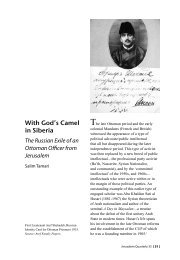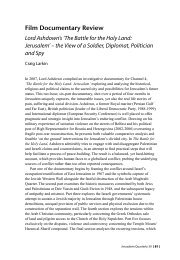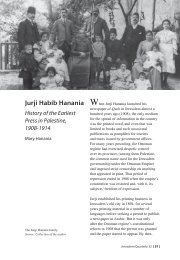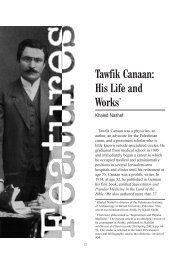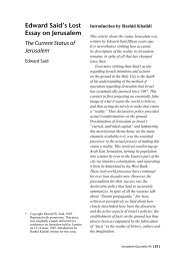PLUNDERING PALESTINE - Jerusalem Quarterly
PLUNDERING PALESTINE - Jerusalem Quarterly
PLUNDERING PALESTINE - Jerusalem Quarterly
Create successful ePaper yourself
Turn your PDF publications into a flip-book with our unique Google optimized e-Paper software.
tomb robbing from foreign archaeologists working in the country, passing this<br />
knowledge to their children and friends later on. A well-known grave digger from the<br />
village of al-Jib (ancient Gibeon) named Muhammad told the author: “The people<br />
of the village learned the nature of digging, and learned stratigraphy and layers from<br />
Pritchard who excavated the village in the 1950s.” This does not mean, however, that<br />
looting is a profitable business, or that local looters are getting huge financial payoffs<br />
from their work. On the contrary, it is a tedious job that doesn’t compensate the<br />
accompanying effort and risks. Besides the danger of being caught by police, grave<br />
diggers face poisonous snakes and scorpions, as well as deadly insects. A digger from<br />
the Hebron area in the southern West Bank named Munther told Reuters: “The most<br />
frightening of all are the Jin [the ghosts]. I am not afraid of the soldiers or the snakes,”<br />
he said. “I am only afraid of the Jin. Sometimes people become sick or go mad from<br />
the ghosts.” He added, “We sometimes bring Muslim sheikhs – holy men – to recite<br />
incantations to drive away the evil spirits from the tombs.” 5<br />
Besides the suppliers, consumers are the main contributors to this destructive<br />
phenomenon. They encourage looting by creating a market demand for antiquities,<br />
and are therefore as guilty, if not more so, as the looters themselves. The main<br />
consumers of Holy Land antiquities are usually foreign collectors who come to the<br />
country as pilgrims and tourists. They make up more than 90 percent of the market<br />
share, while Israeli and international museums that lack specific policies prohibiting<br />
the purchase of unprovenanced artefacts consume the rest. Antiquity thieves are<br />
looking mostly for gold, coins, glassware and ceramic pieces like oil lamps, clay<br />
stamps and items bearing written inscriptions. These objects can sell for hundreds,<br />
sometimes thousands, of dollars if they are found intact. 6 If, for example, they come<br />
across a skeleton wearing gold or silver jewellery, they will break the skeleton to get<br />
the bracelets or necklaces, and in the process destroy significant historical data.<br />
Clearly, if there is going to be a solution or even an ease to the problem of looting,<br />
changing the public’s attitude towards cultural heritage must come first. This means<br />
changing the attitude of illegal excavators’ and collectors themselves, but more<br />
importantly changing the general public’s tolerance towards those people and their<br />
activities. We should stand firm against activities like illicit digging, grave robbing and<br />
above all towards trade in antiquities, and reject any excuses presented by the diggers<br />
and dealers to justify their actions. Such justifications usually vary from need and lack<br />
of job opportunities, to reaching treasures before foreigners reach them. In fact this<br />
later excuse is often cited by diggers to justify their illegal actions, and it is sometimes<br />
accepted by the general public in the local communities. An excavator from al-Jib<br />
accused the famous American archaeologist James Pritchard, the excavator of Gibeon<br />
in the 1950s, of encouraging illegal digging 7 :<br />
[ 42 ] FEATURES VieLooting and ‘Salvaging’



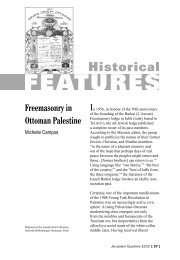
![In Search of Jerusalem Airport [pdf] - Jerusalem Quarterly](https://img.yumpu.com/49007736/1/180x260/in-search-of-jerusalem-airport-pdf-jerusalem-quarterly.jpg?quality=85)

